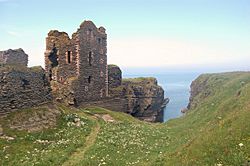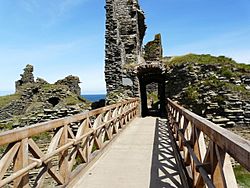John Sinclair, Master of Caithness facts for kids
John Sinclair, Master of Caithness (died 1576) was a Scottish nobleman. He was an important figure in the history of the Clan Sinclair in Scotland.
Quick facts for kids
George Sinclair
|
|
|---|---|
| Master of Caithness | |
| Predecessor | George Sinclair, 4th Earl of Caithness |
| Successor | George Sinclair, 5th Earl of Caithness |
| Died | 15 March 1576 |
| Noble family | Clan Sinclair |
| Father | George Sinclair, 4th Earl of Caithness |
| Mother | Elizabeth Graham |
Contents
Early life and family
John Sinclair, Master of Caithness, was the oldest son of George Sinclair, 4th Earl of Caithness. His mother was Lady Elizabeth Graham. She was the daughter of William Graham, 2nd Earl of Montrose.
Becoming Master of Caithness
The title "Master of Caithness" meant John was the next in line to become the Earl of Caithness. On October 2, 1545, he received an official document called a charter. This charter confirmed that he and his male children would inherit the earldom of Caithness.
In July 1569, John Sinclair led a siege against Lord Oliphant. This event took place at Old Wick Castle, near the town of Wick.
Family conflicts and later life
John's father, George, the Earl of Caithness, had a long-standing feud with the Earl of Sutherland and the Murrays of Aberscross family. This led to a battle in 1570 called the Battle of Torran-Roy. After this battle, John Sinclair tried to make peace with the Murrays. However, his father was very unhappy about this. Because of his actions, John was put in prison by his own father.
John Sinclair, the Master of Caithness, passed away in 1576. He died at Castle Sinclair Girnigoe, which was a family castle. His remains were buried in the "Sinclair Aisle" at the churchyard in Wick. His father had built this part of the church some years before. The words on his grave say: "Here lies the entombed ane noble and worthie man, John, Master of Caithness, who departed this life in the 15th day of March, 1576".
His children
In 1543, John Sinclair received another charter from Mary, Queen of Scots. This document made sure that the Earldom of Caithness would only pass down through the male family line.
John Sinclair married Jean Hepburn. She was the daughter of Patrick Hepburn, 3rd Earl of Bothwell. They had several children:
- George Sinclair, 5th Earl of Caithness: He later became the 5th Earl of Caithness.
- James Sinclair: He was the first of the Sinclair family to live at Murkle.
- John Sinclair: He was the first of the Sinclair family to live at Greenland and Rattar.
- Agnes Sinclair.
- Henry Sinclair: He was an illegitimate son. He is thought to be an ancestor of the Sinclairs of Lybster. Henry went with George, Earl of Caithness, on a trip to Orkney. He died there while they were trying to take Kirkwall Castle.
- David Sinclair: He was also an illegitimate son. He became the laird of Stirkoke in 1587.
See also



